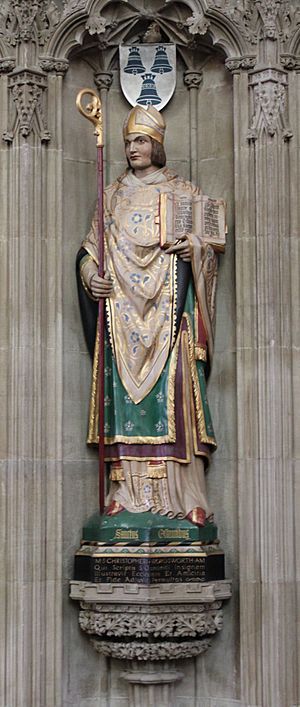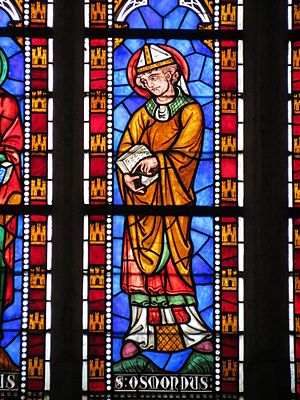Saint Osmund facts for kids
Quick facts for kids Saint Osmund |
|
|---|---|
| Bishop of Salisbury | |
 |
|
| See | Diocese of Salisbury |
| Appointed | 1078 |
| Reign ended | 3 or 4 December 1099 |
| Orders | |
| Consecration | c. 3 June 1078 |
| Personal details | |
| Born | Seez, Normandy |
| Died | 3 or 4 December 1099 Salisbury |
| Sainthood | |
| Feast day | 16 July, 4 December |
| Venerated in | Catholic Church Church of England |
| Canonized | 1 January 1457 by Pope Callixtus III |
| Patronage | insanity; mental illness; mentally ill people; paralysed people; paralysis; ruptures; toothache |
| Lord Chancellor | |
| In office 1070–1078 |
|
| Monarch | William I of England |
| Preceded by | Herfast |
| Succeeded by | Maurice |
| Shrines | Salisbury |
Osmund (who died on December 3, 1099) was a Norman nobleman and church leader. He was also known as the Count of Sées. After the Norman conquest of England, Osmund became an important government official called the Lord Chancellor from about 1070 to 1078. He then became the second bishop of Salisbury, a major church position.
Contents
Osmund's Early Life and Career
Osmund was born in Normandy, a region in France. He came to England with William the Conqueror, who was the Duke of Normandy. Around 1070, Osmund became the King's Chancellor. This was a very important job in the government.
He helped with many official tasks. For example, he was one of the main people who helped create the Domesday Book. This book was a huge survey of all the land and property in England. It helped King William know what he owned and who owed him taxes.
Becoming Bishop of Salisbury
Osmund became the Bishop of Salisbury around June 3, 1078. He was chosen for this role by Pope Gregory VII. Archbishop Lanfranc officially made him a bishop.
His church area, called a diocese, covered three counties: Dorset, Wiltshire, and Berkshire. Before Osmund, these areas had separate bishops. But in 1075, they were combined into one large diocese under Salisbury.
The city of Salisbury where Osmund served was not like cities today. It was more like a strong fort built on a high hill. It had thick walls around it. One writer described it as a fortress, not a city.
Some historians think Osmund might have helped educate Henry I. Henry later became king. He spent a lot of time with Bishop Osmund when he was young, from about 1080 to 1086.
In 1086, Osmund was at a big meeting called the Great Gemot in Old Sarum. At this meeting, the Domesday Book was officially accepted. All the powerful landowners also promised loyalty to the king.
Osmund's Death and Burial
Osmund died on the night of December 3, 1099. After his death, the bishop position was empty for eight years. Then, Roger of Salisbury became the new bishop. Roger was a skilled politician and advisor to King Henry I.
Osmund was first buried at Old Sarum. Later, in 1457, his remains were moved to New Salisbury. They were placed in the Lady Chapel of the cathedral. However, his fancy shrine was later destroyed during the time of Henry VIII. Today, a simple flat stone with the year "1099" marks his resting place in the cathedral.
Osmund's Important Contributions
Osmund did three very important things during his time as bishop.
Building the Cathedral
First, he oversaw the building of the Old Sarum Cathedral. This grand church was finished and officially opened on April 5, 1092.
Organizing the Cathedral Body
Second, Osmund set up the way the cathedral was run. He created a system based on the usual Norman style. This included important roles like a dean, precentor, chancellor, and treasurer. Each of these roles had clear duties.
There were also about 32 canons, who were like special priests. They lived in their own homes and helped the bishop. Their jobs included leading church services and doing missionary work. Osmund also started a school for clergy, which was led by the chancellor. This made the cathedral the main church for the whole diocese. Osmund's canons were known for their musical skills and love of learning. They helped other cathedrals set up their own systems.
Creating the Sarum Use
Third, Osmund created what is known as the "Sarum Use". This was a special set of rules for how church services and prayers should be done. He looked at different practices around him and organized them. He made changes to older church traditions, combining Norman and Anglo-Saxon ways.
The Sarum Use was first meant for his own diocese. But within 100 years, it was used almost everywhere in England, Wales, and Ireland. It even spread to Scotland around 1250.
The "Register of St. Osmund" is a collection of important documents. It includes a book called the "Consuetudinary", which describes church duties. It also has documents and charters about building the cathedral, setting up the church body, and its treasures. This collection shows how well-organized Osmund was.
Osmund's Character and Legacy
William of Malmesbury, a famous writer, described Osmund as a very pure and honest person. He was strict with people who needed to confess their sins, but he was just as strict with himself. He was not greedy and did not waste his own money or try to get wealth from others.
Osmund also built a good library for his canons. It was noted that he even copied, decorated, and bound books himself. While this was unusual for a bishop later on, it was not uncommon in the 11th century.
At one point, Osmund disagreed with Archbishop Anselm during a dispute about who should appoint church leaders. In 1095, he sided with the king. However, after a church council in 1099, he bravely supported the archbishop. There is a story that Osmund knelt before Anselm to ask for forgiveness, showing his true sincerity.
Osmund greatly respected Saint Aldhelm, an earlier bishop. He helped move Saint Aldhelm's remains to a new shrine and helped get him recognized as a saint.
People tried to get Osmund recognized as a saint for a long time. The process started in 1228, but it took almost 230 years! Finally, on January 1, 1457, Pope Callixtus III officially declared him a saint. In 1472, Pope Sixtus IV offered a special reward for visiting his cathedral on his feast day. December 4 was set as the day to remember him.
Osmund is still remembered today. A house at Bishop Wordsworth's School is named after him. There is also a statue of him on the west front of Salisbury Cathedral. The Church of England remembers him on July 16.


